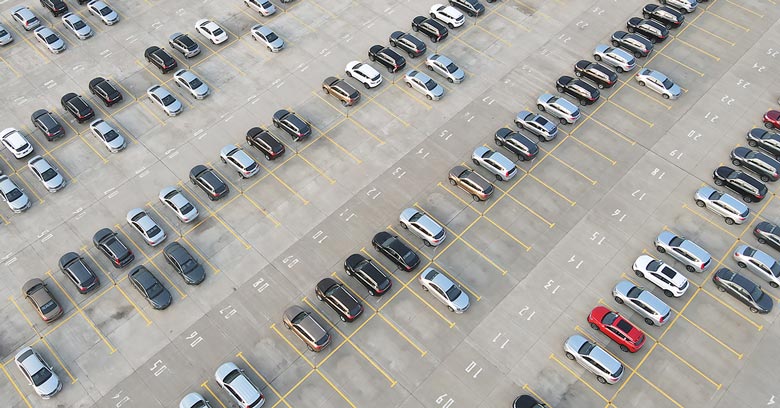
VinFast (VinFast LLC) is known as Vietnam’s first automobile brand, the company was founded with the backing of Vingroup, one of the most influential conglomerates in the nation.
VinFast’s Importance to Vietnam’s Automobile Industry
With the ambition to build a high-class Vietnamese brand and gain international recognition, VinFast has made continuous efforts in the design and technology of automobile production in recent years. From January to October 2021, the company recorded a remarkable growth of 97.7%.
In 2021, VinFast earned much attention with the launch of two electric car models in the US and the establishment of the first electric vehicle battery factory in Vietnam. VinFast first introduced two electric vehicle models VF e35 and VF e36 in November at the Los Angeles Auto Show (LAAS) 2021. By the end of 2021, the company confirmed that they would participate in the Consumer Electronics Exhibition (CES) 2022 where they would introduce 3 more new electric car models. VF e35 and VF e36 respectively belong to class D (large car) and class E (top class car), the 3 new models at CES 2022 are revealed to cover class A (mini car), B (small car), and C (medium-sized car).
Vietnam’s Electrical Vehicle Charging Infrastructure
To serve the electric vehicle ecosystem in Vietnam, VinFast is planning to install 2,000 electric vehicle charging stations in 63 provinces and cities, which corresponds to more than 40,000 charging stations of all kinds. On an area of about 8 hectares in central Vietnam, the group has begun the construction of a 174 million USD battery factory for the VinFast electric vehicle business. The factory is expected to produce up to 1 million battery packs per year, significantly increasing the scale of the domestic electric vehicle battery manufacturing industry.
Being on the upswing, VinFast also plans to expand its business and promote the Vietnamese automobile globally. After announcing plans to enter the European and North American markets in 2022, VinFast opened offices in both regions; California is one of the first places in the US to have a VinFast showroom. The company directly distributes its products in Germany, France, and the Netherlands. The next step in the expansion plan will include Italy, Scandinavia, Switzerland, and Austria.
Vietnam’s automobile market potentials
Along with the success of VinFast, the Vietnamese auto industry is also experiencing positive developments. Although the nation’s rate of car ownership per capita is still much lower than other markets in Asia (only around 5.7% of Vietnamese households owned a car in 2020), Vietnam is still one of the countries with the fastest-growing purchasing power for personal cars over the past ten years. 9% of the Vietnamese households are expected to own a car by 2025 – equivalent to the current level of India and the Philippines. By 2030, car ownership will reach 30%.
This growth trend is expected to be continued by multiple drivers. Apart from the populations’ increasing income, some key factors driving this growth are the change in government policy towards the auto industry and Vietnam’s active participation in many free trade agreements. Particularly, from the beginning of December 2021, the Ministry of Finance has officially announced a 50% reduction in registration fees for domestically assembled cars. The cut fee has helped to lessen the dependence on imported cars and promote domestic automobile production. This fee will also be 100% exempt for battery-powered electric cars, so businesses are more encouraged to invest in the production of electric vehicles. Regarding international trade, in two important free trade agreements (FTAs) the country has joined – CPTPP and EVFTA, Vietnam commits to reduce and eliminate import car tax in the next 7 to 13 years. The upcoming RCEP will enhance the effects even more. Tax reductions on imported cars, coupled with the ability to produce domestic vehicles, will undoubtedly boost the local automobile industry.
Vietnam’s exports of automobile components
Regarding exports, despite being a country that imports 75% of car assembly components, Vietnam also exports a huge number of auto parts every year to major markets such as the US, Japan, South Korea, China, Thailand, and Germany. Specifically, in the first six months of 2021, Vietnam exported more than 1.3 billion USD worth of auto parts to Japan, nearly 1.1 billion USD to the US, more than 230 million USD to China, and more than 330 million USD to South Korea. The export value is usually 1.5 – 2 times higher than the value of auto parts that Vietnamese enterprises import. The export outlook in the automobile market of Vietnam will increase even more in the future under the effects of FTAs and the rise of the electric battery production industry.
Like many other industries, Vietnam’s auto industry was also influenced by Covid-19. In the third quarter of 2021, when the country experienced the worst wave of new cases since the start of the pandemic, most auto businesses recorded a net loss. However, in the fourth quarter, the situation improved massively when the Vietnam government accelerated the pace of vaccinations, loosened pandemic prevention measures, and started implementing reopening strategies. The domestic vehicle market in October 2021 has been recovering, net sales reached 43.6% above pre-pandemic levels. 39,348 units have been sold in October (-7%), leading to total sales from January to October 2021 at 279,043 units (+2.6%).
With the development of electric vehicles, the battery industry for electric vehicles, the increasing demand for automobiles, and the supporting policies from the government, the Vietnamese automobile market owns many advantages to develop even more and shows ample investment opportunities.
Read more about our expertise in the automotive sector or see our other consulting capabilities.
The insights provided in this article are for general informational purposes only and do not constitute financial advice. We do not warrant the reliability, suitability, or correctness of the content. Readers are advised to conduct independent research and consult with a qualified financial advisor before making any investment decisions. Investing in financial markets carries risks, including the risk of loss of principal. Past performance does not guarantee future results.
The views expressed herein are those of the author(s) and do not necessarily reflect the company's official policy. We disclaim any liability for any loss or damage arising from the use of or reliance on this article or its content. ARC Group relies on reliable sources, data, and individuals for its analysis, but accuracy cannot be guaranteed. Forward-looking information is based on subjective judgments about the future and should be used cautiously. We cannot guarantee the fulfillment of forecasts and forward-looking estimates. Any investment decisions based on our information should be independently made by the investor.
Readers are encouraged to assess their financial situation, risk tolerance, and investment objectives before making any financial decisions, seeking professional advice as needed.



